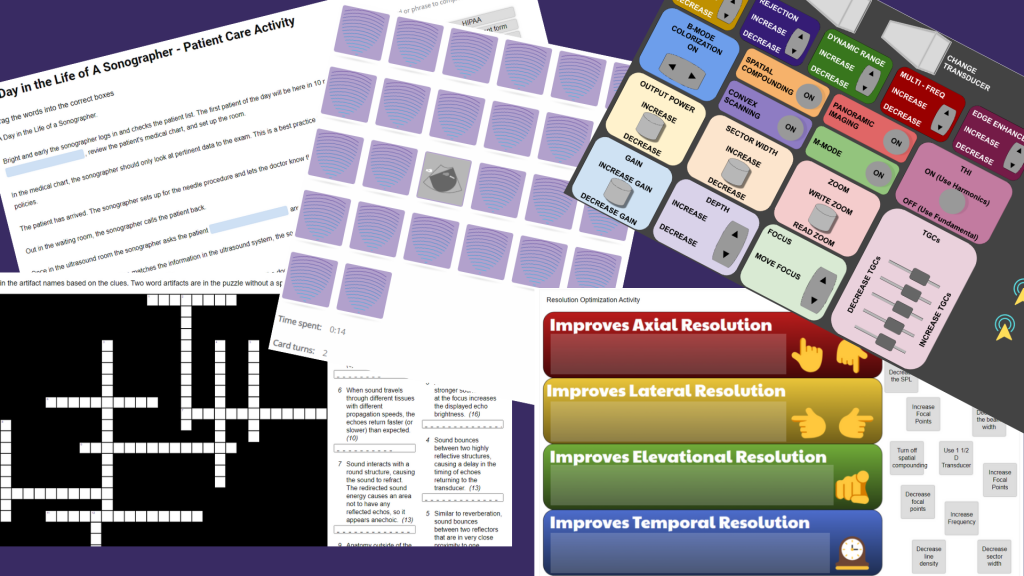On September 1st, 2023, the American Registry for Diagnostic Medical Sonography (ARDMS) changed the content outline for the Sonography Principles and Instrumentation (SPI) examination.
It has been about three months since the new SPI test was introduced, and we have been scouring the internet to see what people are saying about the changes.
We have compiled some great feedback from those who have already taken the test, and we want to share some tips with you that we think will be helpful for your upcoming SPI exam. We aim to ensure that you succeed and achieve your goals.


What is the SPI?
If you are new to sonography, here’s a quick overview of the certification process through the American Registry for Diagnostic Medical Sonography (ARDMS).
To become a certified sonographer, you are required to take two exams: the first one is the Sonography Principles and Instrumentation (SPI) exam, which includes acoustic physics and using ultrasound machines. The second one is a specialty exam that covers anatomy and pathology, such as adult echo, breast, musculoskeletal, OB/GYN, and more.
Passing both exams will certify you as a registered sonographer.
Apart from ARDMS, there are other pathways to becoming a registered sonographer. Cardiovascular Credentialing International (CCI) is another common certification organization for vascular and heart sonographers, while the American Registry of Radiologic Technologists (ARRT) also offers certification tests. Both exams include a physics component, but the physics is integrated as part of the exam rather than a separate exam.
SPI Exam Insights: Test Structure
The SPI is a multiple-choice test with 110 questions, and you are given 2 hours to complete it. You need to score 555 out of the 700 available points to pass the test.
It’s important to note that the test has multiple versions. However, it is a common misconception that the test is adaptive, meaning the questions change based on your previous answers.
This is not true. All the questions are loaded when you start the test.
Understanding that not all 110 questions are equally weighted is helpful. Some questions are worth more points because they cover core knowledge. These questions require more attention and accuracy to get a passing score.
On the other hand, the harder questions are worth less, which gives you a little more wiggle room to make mistakes.

 It’s important to note that some questions on the ARDMS test are worth ZERO points.
It’s important to note that some questions on the ARDMS test are worth ZERO points.
These questions are called pilot questions, which means that the ARDMS uses them to determine how well the question is written and how difficult it is. The information gathered from pilot questions is then used to improve future test versions.
As a result, you may encounter some really challenging questions.
If you come across a question that you don’t know how to answer, don’t get stuck on it. You can flag the question, move on to the next one, and come back to it later.
Additionally, keep in mind that if you encounter a question concept that you are unfamiliar with, it may be worth less or is a pilot question.
Pathways to SPI Eligibility: Requirements and Application Process
As a disclaimer, you should always do your own research and verify with the ARDMS what your eligibility is for taking the SPI.
Generally, there are a few different pathways to become eligible for the SPI exam. However, you must have a basic understanding of physics. This can be achieved through several methods, such as:
You can take the SPI exam at home or at a Pearson Vue testing center. However, taking the exam at home can be a bit tricky, and the experience can vary from person to person. While some applicants find it reduces their test anxiety, others have had poor experiences. Keep in mind that the testing centers book up quickly, so you should weigh the pros and cons before deciding.
SPI Exam Content Outline: Navigating the 5 Domains
One of the really cool things ARDMS does to help applicants is to give us a roadmap to what is on the test.
This is called the SPI content outline.
The SPI test is divided into five domains, each accounting for a specific percentage of the test. These domains are:
- Perform Ultrasound Examinations (23% – approximately 25 questions)
- Manage Ultrasound Transducers (7% – approximately 8 questions)
- Optimize Sonographic Images (26% – approximately 29 questions)
- Apply Doppler Concepts (34% – approximately 37 questions)
- Provide Clinical Safety & Quality Assurance (10% – approximately 11 questions)
Each domain involves various tasks, knowledge, skills, and abilities that may be included in the test. The current SPI content outline might look very different from the previous one. Still, we noticed that the difference is more a reorganization and renaming of material versus adding too many new topics.
When we compare the new SPI content outline to the previous one, we notice some significant changes, including:
- Domain #1 has been renamed.
- It now includes the actual performance of an ultrasound exam AND all the core physics concepts like parameters, attenuation, etc.
- Domain #3 has been renamed.
- This section now really emphasizes the application of physics.
- The percentage of questions for Domain #2 has significantly reduced.
- We suspect it’s much more about why you choose a certain transducer and how the transducers do what they do than knowing about outdated technology.
- There has been a slight increase in question percentage for Domain #4.
- You have to know Doppler concepts. There just isn’t an easy way around it.
Behind the SPI Changes: Understanding ARDMS’s Evaluation Process
You might be wondering why the SPI changed. In response to an evaluation conducted by the ARDMS, changes were made to the SPI exam. The purpose of the evaluation was to better understand sonographers’ daily use of instrumentation and physics principles. To achieve this, a survey was sent out to over 2,900 sonographers to identify areas on the SPI that needed more representation or were outdated testing points as the machines and technology evolved. Based on the feedback received, the SPI exam was updated to ensure that it remains relevant and reflects the current standards and practices in the field of sonography.
Focus on Application: The Shift in SPI Exam Emphasis
Upon reviewing the report, it appears that the ARDMS is placing more emphasis on the APPLICATION of skills and knowledge of sonographers. Specifically, they are interested in how sonographers can optimize machine settings to produce high-quality images, enhance resolution for different situations, utilize physics and “knobology” to create a Doppler image, and ensure the safety of patients during the ultrasound process.
We believe that this shift in focus is a positive development!
It directs attention toward the practical application of physics in our jobs rather than the highly technical aspects and formulas involved in operating an ultrasound machine. Nonetheless, it is worth noting that while understanding the machine’s internal mechanisms is crucial and does still show up on the SPI, much more stress is placed on the importance of applying this knowledge.
Our interpretation of the report leads us to believe that ARDMS recognizes the significance of a sonographer’s skills and expertise in producing accurate and detailed images that can aid in accurate diagnoses. By emphasizing the practical aspects and applications of sonography, this test assesses an entry-level sonographer’s ability to operate the machine thoroughly and safely.
SPI Exam: What People Are Saying – General Feedback and Insights
It’s important to keep in mind that when you take a standardized test, you typically agree to keep its contents confidential. We appreciate those who have provided general feedback on social media and other forums.
However, this feedback is simply people’s experience with the test(that was shared on the internet), as viewed through my lens as a subject expert. It’s important to note that everyone’s experience may be different and that multiple versions of the test help ensure that there will be diverse experiences.
Are there any formulas or conversions on the SPI?
To answer this question directly, the answer is no. You won’t be required to calculate values based on memorized formulas.
In fact, you’ll only be provided with a simple calculator and a whiteboard.
The conversions you’ll need to make are likely to be basic, such as converting millimeters and centimeters like we do when completing worksheets.
You should know your relationships.
 You might opt to memorize relationships.
You might opt to memorize relationships.
For example, you may have already memorized that when the wavelength decreases, frequency increases because they are inversely related.
But, that’s a lot of relationships to memorize.
Try taking it a step further, and work on knowing formulas. If you know that the formula for wavelength is: λ= c/f, you can infer a relationship from the formula based on where the variables appear.
It is even more helpful for longer formulas like the Doppler formula. This one formula tells us 5 different relationships and we don’t have to memorize each one if we know the formula.

Everything above the fraction bar (the numerators) is directly related to the Doppler shift, whereas everything under (the denominators) is inversely related to the Doppler shift.
Find the method that works best for you. If formulas and math still stress you out, the math will most likely amount to knowing that if a variable doubles, directly related variables will also double, whereas inversely related variables would halve.
Ultimately though, you want to work toward really understanding the concepts. Going back to our wavelength formula, we know that frequency and wavelength are inversely related. Higher frequencies have shorter wavelengths.
When the wavelength is short, the spatial pulse length is short. When the SPL is short, the axial resolution improves. This is why we choose high-frequency transducers when detail is important.
Artifacts, Aliasing, and Resolutions: What to Expect on the SPI
Are there images on the SPI exam?
It sounds like the answer to this one is “not too many.” However, that will mean knowing how to describe aliasing and artifacts with words, so be sure to brush up on your definitions and ultrasound terminology for different echogenicities.
Know how to fix artifacts.
Speaking of artifacts, make sure you know how to fix both grayscale and Doppler artifacts. This entails knowing why the artifacts occur and what you can do as a sonographer to reduce or remove artifacts.
Aliasing is a type of Doppler artifact. This one is HUGE. You should know the five ways of correcting for aliasing like the back of your hand:
- Increase PRF
- Move the baseline
- Decrease frequency
- Decrease the depth of the sample volume
- Switch to CW
Take this knowledge a step further and understand why these methods work, and you’ll be even more prepared.
What do I need to know about resolution?
Resolution was identified by a lot of people as a MUST KNOW. We can see that from the outline too. The big four resolutions are axial, lateral, elevational, and temporal. You will want to know what improves or worsens each type of resolution. This is where optimization and application come in for Domain #3.
For those who attend the ESP Ultrasound Physics Webinar, we have added more content and activities like these that address Domains #1 and #3 in our X-ZONE platform.

Anything else?
Some other common concepts that were mentioned were the different compounding types, attenuation, and dynamic range.
Remember that everything on the SPI content outline is fair game. For the larger sections, there will probably be multiple questions asking about the same concept. So don’t be surprised if it feels like you have a lot of questions about a topic.
SPI Study Tips: Strategies for Success and Recommended Resources
We appreciate everyone who has chosen ESP Ultrasound products. We have lots of resources available to help you study, and we’re excited to see so many people recommending our study tools. Here are some general tips that have been given over the years:
- Make a study plan. Don’t leave everything to the last minute. Give yourself plenty of time to feel confident and well-prepared.
- Use practice questions. There are many options out there, but we recommend X-ZONE. The main goal is to get feedback and mimic the test-taking experience.
- Focus on your weak areas first. Taking a practice test will help you identify these areas. Study them before taking another practice test.
- Attend a course or webinar. A course like ESP’s has a workbook that helps streamline the information and X-ZONE, so you have everything you need.
- Use the Understanding Ultrasound Physics book. Our book is highly recommended. It makes the content clear and is less dry than other textbooks.
- Study to understand, not just to memorize. When you know the content, you’ll be less likely to forget things.
- Watch YouTube videos. Revisiting topics or seeing them explained differently can be helpful.
- Get a tutor. Personalized help may be one of the best investments you can make in yourself.




